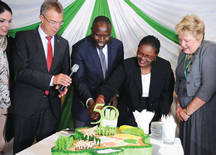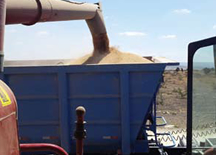Seize The Moment to End Hunger Globally
 For the first time in human history, the end of hunger is well within our reach. While courageous and passionate individuals have been working to end this scourge for decades, a recent confluence of political will, public-private partnerships and funding has made this ambition possible.
For the first time in human history, the end of hunger is well within our reach. While courageous and passionate individuals have been working to end this scourge for decades, a recent confluence of political will, public-private partnerships and funding has made this ambition possible.
By Kofi Annana
We have, of course, a long way to go. Almost 800 million men, women and children will not have enough food to eat today. But the achievement of halving the proportion of malnourished people since 1990 has shown us just what can be achieved.
Look, for example, at Africa. When I was UN Secretary-General, I called for a “uniquely African Green Revolution” to transform agriculture and the life chances of hundreds of millions of people on the continent. Progress has been remarkable.
For over a decade, African countries have put a much greater emphasis on investment in agriculture and supporting the continent’s farmers. The Comprehensive Africa Agriculture Development Program (CAADP), launched by African leaders in 2003 and reiterated in the Malabo Declaration of June 2014, provides a clear framework to accelerate investment and coordinate countries’ efforts. International donors have thrown their weight behind these national efforts.
Read more ...
CIMMYT Fifty Years Celebrations in Nairobi
 The International Maize and Wheat Improvement Center (CIMMYT) held its eastern and central Africa 50th anniversary celebrations on 9 – 10 September, 2016. The event was hosted by CIMMYT’s regional office in Nairobi, Kenya, bringing together over 150 stakeholders, partners, dignitaries, donors and staff to take stock of achievements made in the region and lessons learned through five decades of partnership, with a focus on the future of maize and wheat research in the region.
The International Maize and Wheat Improvement Center (CIMMYT) held its eastern and central Africa 50th anniversary celebrations on 9 – 10 September, 2016. The event was hosted by CIMMYT’s regional office in Nairobi, Kenya, bringing together over 150 stakeholders, partners, dignitaries, donors and staff to take stock of achievements made in the region and lessons learned through five decades of partnership, with a focus on the future of maize and wheat research in the region.
CIMMYT Director General Martin Kropff led the event and encouraged staff to share CIMMYT’s impact in eastern and central Africa and strategic vision the organization has adopted for the future. Guests also had an opportunity to view CIMMYT and partner activities in the three major research sites in Kenya and give feedback on CIMMYT’s work.
Seed companies, national agricultural research organizations and long-serving CIMMYT staff were presented awards recognizing the long and fruitful collaboration between them and CIMMYT. A tree was planted in honor of the late Wilfred Mwangi, who was CIMMYT’s Regional Liaison Officer in Africa. These hunger fighters must embrace technological innovation, creativity, bold ideas and collaborate across all disciplines, while also effectively engaging smallholder farmers and private and public sectors to come up with sustainable solutions, Borlaug said, adding that the average age of a farmer in the United States and Africa is well over 50 years.
Read more ...
 One of the ways that the Kenya Government can support farmers and consumers is through the zero-rating of inputs, and processed food, eliminating the additional cost that would result from such charges.
One of the ways that the Kenya Government can support farmers and consumers is through the zero-rating of inputs, and processed food, eliminating the additional cost that would result from such charges. For the first time in human history, the end of hunger is well within our reach. While courageous and passionate individuals have been working to end this scourge for decades, a recent confluence of political will, public-private partnerships and funding has made this ambition possible.
For the first time in human history, the end of hunger is well within our reach. While courageous and passionate individuals have been working to end this scourge for decades, a recent confluence of political will, public-private partnerships and funding has made this ambition possible. The International Maize and Wheat Improvement Center (CIMMYT) held its eastern and central Africa 50th anniversary celebrations on 9 – 10 September, 2016. The event was hosted by CIMMYT’s regional office in Nairobi, Kenya, bringing together over 150 stakeholders, partners, dignitaries, donors and staff to take stock of achievements made in the region and lessons learned through five decades of partnership, with a focus on the future of maize and wheat research in the region.
The International Maize and Wheat Improvement Center (CIMMYT) held its eastern and central Africa 50th anniversary celebrations on 9 – 10 September, 2016. The event was hosted by CIMMYT’s regional office in Nairobi, Kenya, bringing together over 150 stakeholders, partners, dignitaries, donors and staff to take stock of achievements made in the region and lessons learned through five decades of partnership, with a focus on the future of maize and wheat research in the region. Machinery’s role in an environmentally sustainable future is a main concern. Farm machines have revolutionized agriculture and reduced drudgery for millions of farm families and workers, but the machinery of tomorrow will have to do more than that – it will also have to contribute to agriculture that is environmentally sustainable.
Machinery’s role in an environmentally sustainable future is a main concern. Farm machines have revolutionized agriculture and reduced drudgery for millions of farm families and workers, but the machinery of tomorrow will have to do more than that – it will also have to contribute to agriculture that is environmentally sustainable.